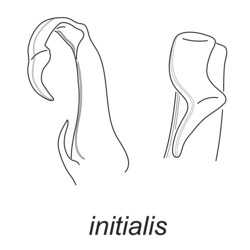Brachoria initialis
The Maplesville Mimic Millipede
Paul MarekCharacteristics
Brachoria initialis individuals are about 38.7 mm long and 9.8 mm wide (females 40.7 mm X 10.0 mm). Color: Combined striped and 2-spotted, purple medial metatergal stripes, pink lateral paranotal spots.


Brachoria initialis genitalia - left male gonopodal acropodite (with seta removed): (Left) medial view and (Right) magnified apical view. © Paul Marek
Habitat
Brachoria initialis specimens were collected during the day (17:30, the Lecompte locality) in an oak forest about 50 m north of Bayou Boeuf Cocodrie. Millipedes were found during rainfall beneath a thin layer of decaying leaves on the sloped bank of the river. Brachoria initialis individuals were also collected on the north-facing bank of Barren Fork in a maple forest in McMinnville, Tennessee (co-occurring with B. hubrichti, see that species for habitat details). One other xystodesmid encountered sympatrically at the McMinnville locality is Brachoria hubrichti, which appears similar in coloration with B. initialis. Individuals of B. initialis may be confused in the field with C. georgiana latassa due to similarity in color patterns and broad overlap in distribution. Individuals of B. initialis may also be confused in the field with B. ochra due to similarity in color patterns and overlap in distribution (co-occurring in northern Alabama, and northeastern Mississippi).Distribution
The largest distribution of any Brachoria species. Known from the highlands of Tennessee from the Valley and Ridges, west to the Nashville Basin. Widely distributed south into the piedmont of southwestern Georgia and south of the Fall Line through the coastal plain in Alabama, Mississippi, and Louisiana. The only species of Brachoria that occurs west of the Mississippi River.Conservation status
Brachoria initialis is threatened by habitat loss due to agriculture (especially growing demand for paper products), coal mining, development, and the invasion of exotic species.References
Marek P.E. 2010. A revision of the Appalachian millipede genus Brachoria Chamberlin, 1939 (Polydesmida: Xystodesmidae: Apheloriini). Zool. J. Linn. Soc. 159: 817-889.
Causey N.B. 1950. A collection of xystodesmid millipeds from Kentucky and Tennessee. Ent. News 61: 5-8.
Chamberlin R.V. 1939. On some diplopods of the family Fontariidae. Bull. Univ. Utah 30: 1-19.
Chamberlin R.V. 1947. Some records and descriptions of diplopods chiefly in the collection of the Academy. Proc. Acad. Nat. Sci. Philadelphia 99: 21-58.
Keeton W.T. 1959. A revision of the millipede genus Brachoria (Polydesmida: Xystodesmidae) Proc. US Nat. Mus. 109: 1-58.
Hoffman R.L. 1999. Checklist of the millipeds of North and Middle America. Virginia Museum of Natural History Special Publication. No. 8. Martinsville: Virginia Museum of Natural History.
Title Illustrations

| Scientific Name | Brachoria initialis |
|---|---|
| Location | USA, Tennessee, Warren Co. |
| Reference | Marek P.E. 2010. A revision of the Appalachian millipede genus Brachoria Chamberlin, 1939 (Polydesmida: Xystodesmidae: Apheloriini). Zool. J. Linn. Soc. 159: 817-889. |
| Specimen Condition | Live Specimen |
| Sex | m |
| Life Cycle Stage | adult |
| View | dorsal |
| Collection | FMNH |
| Collector | Paul Marek |
| Image Use |
 This media file is licensed under the Creative Commons Attribution-NonCommercial License - Version 3.0. This media file is licensed under the Creative Commons Attribution-NonCommercial License - Version 3.0.
|
| Copyright |
© Paul Marek

|
About This Page
Work on the millipede Tree of Life pages was supported by a U.S. National Science Foundation Doctoral Dissertation Improvement Grant to Paul Marek and Jason Bond (DEB 0607996) and a Partnerships for Enhancing Expertise in Taxonomy Grant to Petra Sierwald, Jason Bond, and William Shear (DEB 0529715).
Paul Marek

Virginia Polytechnic Institute and State University
Correspondence regarding this page should be directed to Paul Marek at
Page copyright © 2010 Paul Marek
 Page: Tree of Life
Brachoria initialis . The Maplesville Mimic Millipede.
Authored by
Paul Marek.
The TEXT of this page is licensed under the
Creative Commons Attribution-NonCommercial License - Version 3.0. Note that images and other media
featured on this page are each governed by their own license, and they may or may not be available
for reuse. Click on an image or a media link to access the media data window, which provides the
relevant licensing information. For the general terms and conditions of ToL material reuse and
redistribution, please see the Tree of Life Copyright
Policies.
Page: Tree of Life
Brachoria initialis . The Maplesville Mimic Millipede.
Authored by
Paul Marek.
The TEXT of this page is licensed under the
Creative Commons Attribution-NonCommercial License - Version 3.0. Note that images and other media
featured on this page are each governed by their own license, and they may or may not be available
for reuse. Click on an image or a media link to access the media data window, which provides the
relevant licensing information. For the general terms and conditions of ToL material reuse and
redistribution, please see the Tree of Life Copyright
Policies.
- First online 16 September 2010
- Content changed 16 September 2010
Citing this page:
Marek, Paul. 2010. Brachoria initialis . The Maplesville Mimic Millipede. Version 16 September 2010 (under construction). http://tolweb.org/Brachoria_initialis/144224/2010.09.16 in The Tree of Life Web Project, http://tolweb.org/






 Go to quick links
Go to quick search
Go to navigation for this section of the ToL site
Go to detailed links for the ToL site
Go to quick links
Go to quick search
Go to navigation for this section of the ToL site
Go to detailed links for the ToL site